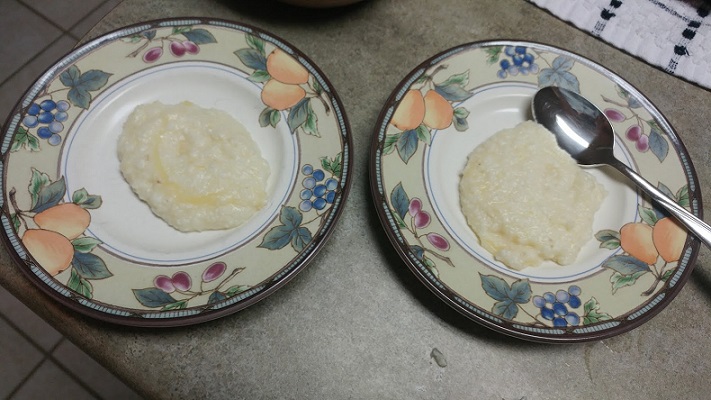Culture | Home Life | Parenting | Personal Growth
Three Types of Grits and The Importance of Each
“What’s that?” my eight-year old daughter asked me, pointing to my bowl a few days ago.
“Grits,” I replied and put a spoonful in my mouth.
“What’s grits?” she asked and turned up her nose.
“It’s….” I started to reply. “It’s from corn. But it’s more than that. Let me think so I can explain.”
Oh. My. Gosh. I’m failing as a mom. I’m failing as a Southerner. How do my children not know about grits? When was the last time I ate them or had them try this Southern staple?
We usually had grits in my house growing up, the instant kind. Don’t judge.
That reminds me of two funny scenes in the film My Cousin Vinny about grits. In the first one Vinny eats his first helping grits where he said, “I just never seen a grit before.” (This always makes me chuckle).
Then later in the movie while in the court room, a man is testifying and being asked about his breakfast. He said he had eggs and grits. Vinny asks him if he had instant grits. He replied, “No self-respected Southerner uses instant grits.” Then an entire scene plays out about “magic grits.” It’s hysterical .

But back to his statement – No self-respected Southerner uses instant grits.
Do you agree? Do my family and friends who eat grits today make it from scratch and wait 20 minutes to eat it?
I beg to differ with the critical character in My Cousin Vinny. Nearly everyone I grew up with used (and still uses) instant grits. It was perfect to go with our breakfasts. I use the instant kind today. I do what they call “doctoring it up” by adding in butter, cheese and bacon grease and bits.
I use instant roux too for gumbo. I’ve made a roux from scratch and it takes a long time and lots of stirring to make it happen and make sure it does not burn. You should try it the long way if you have the time and want to be more authentic, but you can also just use these wonderful, faster tools that some gracious cooks have worked tirelessly to make and supply for us to make our lives easier.
So that’s one type of grits/grit. The kind you eat.
After that conversation with my youngest daughter, I prepared the instant grits and doctored it up with butter, cheese and bacon grease for my kids the next day. My youngest daughter does not like grits but at least she tried it. For her I think she doesn’t like the texture or gritty feel to it. My oldest daughter ate them and said she thought they were OK but prefers other foods.
I guess maybe I have failed in the mom who gets her kids to eat grits/food department.
But there’s another kind of GRITS that I wonder if I’ve failed at. Probably so. The kind that it stands for.
Of course, if you’re a girl from the south, like I am, then you think of what the letters in G.R.I.T.S. stand for – I heard it growing up and used it myself in college quite a bit: GIRLS RAISED IN THE SOUTH.
If you’re from the South, you have to have that Southern pride. There’s also Southern charm. I believe both of these are real things. But…
But I’ve also lived in the North. We moved to Dayton, Ohio and lived there for two and a half years. People living there are also charming and proud of their surroundings and upbringing. Does that make Northerners charming and proud too?
Eventually we moved south again following job offers my husband received. We lived near Montgomery, Alabama and then settled in Pensacola, Florida where we’ve been the last 10 years. And we enjoy living where we are now.
But is Pensacola really Southern? I don’t know. In some ways it is, I think. In some ways it’s more a mix of different people – a lot of military families, people who came here for training or some other reason (like us) mixed in with people who have lived here their whole life and people who came to visit here once or multiple times and liked it so much that they bought homes to retire here (several friends of mine did this).
So maybe I can call myself part of the GRITS gang, but I don’t think my daughters would be or consider themselves to be. And I don’t think that’s a bad thing either. Because as we’ve learned, there are charm and pride in every place.
I am so grateful for the place where I’ve grown up, different places where I moved and lived for several years and of course where I live now. That leads me to the third and final thought about grit(s).
When I think about grit, or grits, I also think about a person having grit. In my mind, that means a person is tough, and is able to endure a lot. A person with grit is known to have courage and strength in her or his character in addition to resiliency.
That is the kind of grit I want to have and keep around. It’s the kind of thing that can help you get through a year like 2020 and other challenges in life.
I’m not saying that I have it, but rather, that I’m working on mine and trying to develop grit. I also recognize that I’ll never have the same grit that others who’ve endured way more than me have.
I just watched a documentary of people with true grit and courage – No Place on Earth is a true story of several families of Ukrainian Jews who spent more than 500 days living underground in caves hiding from the Nazis during World War II. These people had grit and a strong desire to live and not give up. Their story was incredible and one that I’m glad I learned about from author Tara Lynn Masih who wrote a fictional book I read called My Name is Hanna that was inspired by the Stermer family depicted in No Place on Earth.
I’ll never have (and hope to never experience) that type of grit that these people faced. Or the kind of grit that any people today feel when they are being hunted/targeted by others because of their religion, skin color or simply some trait about them that makes up who they are or how they were born.
So maybe I can’t force my kids to eat or like the food grits, even though I love it, especially on a cool or cold day. It warms my belly and my soul.
And maybe my daughters won’t be G.R.I.T.S., as in girls raised in the south like I am/was, because of where they live and where they were born and where they are growing up now.
But I do plan to teach them and talk to them about grit and grits – people who have it, people who have been forced to deal with it and how we can tell their stories, share their stories and find our own small bits of it when we need it.
What about you? Do you like grits? Are you among the GRITS? Do you have grit or know someone who does?


melanie m fernandez
Great blog. As a G.R.I.T.S. I feel that New Orleans is and is not "Southern". We are definitely more cosmopolitan and have more of a melting pot than Tupelo Mississippi, for example. But we have the slow moving lifestyle, ease of smile to strangers and love of hometown traditions. As for the first kind of grits, I have always loved them because I didn't like eggs and they were a good substitute on a busy morning. New Orleanians grew up eating lots of things like grits, crawfish, crabs and fish without ever questioning them. As for the final grit, every day in life helps you build up this trait, if you only try. I too hope I will never be put to the ultimate test that many people are. Life just keep changing and we all are just working to hang on.